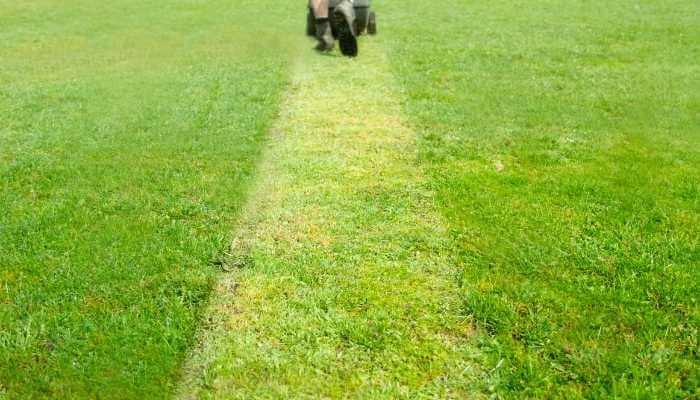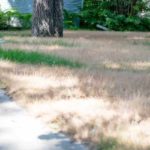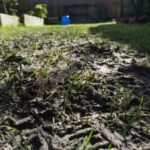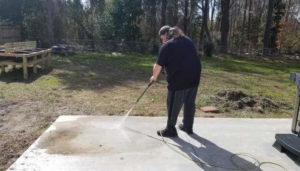People scalp grass in their yards accidentally, all the time. But did you know that sometimes you should scalp your yard on purpose?
Scalping your yard is when you cut the grass blades to the right above the crowns of the grass, by lowering your mower to the lowest setting. The best time to scalp is if you have a lot of thatch in your grass or if it’s part of your spring lawn maintenance, after the last frost.
Need specifics? Well, keep reading!
What Is Lawn Scalping?
Grass or lawn scalping is cutting your grass low enough that you expose the stems of the plant. You can scalp your lawn in a fashion that is helpful or in a fashion that is harmful. It helps to get rid of the brownish, dead portion of your grass and the layer of organic material between the grass blades and the soil. This is called thatch, and removing it exposes the soil and stems to sunlight.
However, if you scalp the yard during the wrong weather period of the year or you cut the grass into the crowns, you can kill it.
You may wonder, how long does it take scalped grass to recover? Now, most warm-season grass will recover quickly. You should begin looking for new grass blade growth within a week of the scalping. If you don’t see regrowth or you have a lawn of cold season grass, the lawn may need to be reseeded while the plants recover over the next month.
How Can I Prevent Lawn Scalping?
Make sure you are aware of thatch in your yard. Thatch is that mixture of organic material that builds up between the green grass and the soil’s surface. The problem with too much thatch build-up is two-fold. However, we’re concerned about scalping in this article, so I’ll focus on that. When you have too much thatch, the lawn mower wheels sink into it and that can cause scalping, even if you don’t intend on it.
Keep your mower’s blade sharpened. This will lessen the mowing you’ll need to do and therefore keep you from wanting to lower the blades. The most important thing you can do to prevent scalping your yard is to find out what the optimum length of your grass should be. Make sure your lawn mower’s blade is at that height and not below it. Keep in mind that land can be uneven and you need to adjust for that.
Use a size chart to be specific about the length of your grass. Here’s a good rule of thumb. If you have cool-weather grass, the grass blades should be about 1 inch or longer. Warm-season grass species should be at least 2 ½ inches long or more.
Not sure what the difference is? I wrote an article about aeration that has a chart concerning grass types.
If you go a week or more without cutting the grass, hit pause on that play. Say you’ve gone on vacation, or you feel like it’s been monsoon season for the last week or two, and that grass has gotten away from you. STOP! Don’t just cut your grass using the normal height setting on your lawn mower.
Think about this. You can scalp your yard by mowing too low. Scalping is cutting the grass blades off right at the crown or growing point of the grass (near the soil). And the taller the grass blade, the higher the crown or growing point.
This means you need to adjust your lawn mower higher when the grass has grown higher.
It makes the most sense to cut a lawn frequently and only cut maybe ⅓ of the grass blade each time you cut it. Once the grass is at a suitable length and is healthy and green, you can then just maintain it. But cut your grass more frequently if you want to avoid scalping and have an all-grass yard.
Remember, if you cut the grass at the right time of the day during the harsh summer season, even if you accidentally scalp it, it should be able to recover. What I’m saying is, when it’s summer, try to cut the grass in the cooler portion of the day and into the afternoon. This will give the grass a break and lessen moisture evaporation in freshly cut grass.
How to Help Your Lawn Recover from Unwanted Scalping
The easiest thing to do for scalped patches of the yard is to reseed the scalped patches and be sure to water them. This way, the seeds will germinate and grow to replace the damaged grass. If you use the same type of grass that is already there, it helps you use the same height for your lawn mower.
When you water the scalped areas, remember to do so with a shower-gentle sprinkler and to water the areas at least twice per week (depending upon rain). When you fertilize the areas, add in some chelated iron. This substance will promote thick, quick blade growth.
When Should You Scalp Your Lawn?
Scalping is part of your lawn’s maintenance. We usually scalp a yard after the last frosts in early spring. Your grass is strongest in this season and has stopped being dormant. Scalping will promote growth and thickness by removing the dormant layer of the grass. This allows air, water, and nutrients to get to your soil.
Another thing that is often removed when you scalp your grass is that thick layer of organic material between the blades of grass and the soil. This is often called “thatch”. Scalping can rid your lawn of over-thatch and also open the area to gentle raking that can also break loose and remove thick thatch. So long as you don’t harm the roots of the grass, removing thatch can open the soil to being able to absorb more water, oxygen, and nutrients.
Scalping to remove thatch is risky, and there are other methods of handling thatch. However, it can work if you scalp warm-season grass only in the spring when there is no more frost and the lawn first becomes green. Just be sure to remove all the large clippings from the lawn afterward.
How to Properly Scalp a Lawn
When you want to scalp your yard, you need to lower your lawn mower to maybe only 1 inch of clearance from the ground and then cut the grass. You should be sure to have a method of catching the clippings so that you don’t add to the thatch layer too much. After all, scalping is a preventative measure for clearing thatch. Some people then go back over the grass in an even lower setting if they need to. But remember, you don’t want to cut the crowns of the grass, just the blades.
Keep in mind that you should only do this in the proper season. That is going to be in spring, right after the last frost and before fresh growth. Many people include scalping in their springtime maintenance regime for their yards.
Be careful about the type of grass that grows via runners. Because if you take out too many of those, you can make your lawn die. Grasses like Bermuda do very well after scalping, so you can set the lawn mower to its lowest height and just go! For other types of grass, be more conservative about the scalping.
In Conclusion
Scalping helps clear away winter debris and thatch from the base of your grass blades. It opens up the soil and the plants to oxygen, nutrients, sunlight, and water. However, you’ve got to do it right and you’ve got to do it at the proper time. Otherwise, you should avoid scalping your lawn. I hope this article helped you understand how to handle both scenarios.













